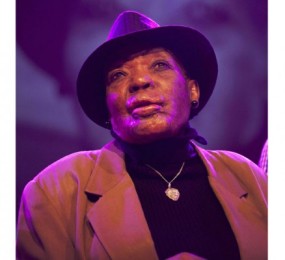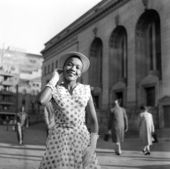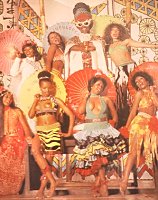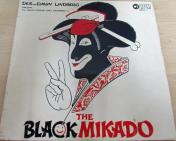Yesterday was a sad day for South African jazz. Although Thandi Klaasen had been suffering severe ill-health for some time, her death from complications following a stroke, aged 86, still felt shocking. She had been such an indomitable musician – and human being – and had shown the capacity to bounce back from setbacks throughout her life.
As the tributes were posted, however, something else shocked: how little many of those tribute-writers knew about Klaasen’s musicianship.
Certainly – because they share a musical generation (she was Madiba’s favourite vocalist), and because Klaasen did feature at some high-profile official events – the tributes from ruling-party politicians felt much more personally sincere than they sometimes do. But, outside family and co-performers, few seemed to know about her music beyond the song Sophiatown, and only the ANCWL even mentioned her outspoken, articulate activism on behalf of women in music (not surprisingly a stock phrase in every tribute that particular organisation publishes).

In fact –emotionally powerful song though it is– the relatively recently-composed Sophiatown (https://www.youtube.com/watch?v=Fu-vBX7oKKU ) was not Klassen’s “greatest hit”. That happened much earlier, in 1952, when Klaasen’s Quad Sisters stormed the charts with the first African female close-harmony vocal recording: Carolina Wam’.
Thandi Mpambane was born in Sophiatown around 1930 (some accounts give 1931). Her father was a shoemaker and her mother a domestic worker, and they were ambitious for their talented, intelligent daughter, whom they sent to St Cyprian’s Anglican school in the hopes she would qualify as a doctor.
Unfortunately for those hopes, the young Thandi had other ideas: “Ha! Marabi!…our mothers used to have these tents…I didn’t know what is or was jazz then. I could only hear this beautiful sound and listening to a singer like Emily Kwenane, and she would [scat] and I would say to myself Thixo! What is this woman doing with this song? I would run to the Communal Hall to hear this wonderful woman singing and my foot is beating all the time…” Long before the St Cyprian’s Choir, where Klaasen also sang, her musical ambitions were already forming; Kwenane was her neighbour in Sophiatown so an approachable role model. “My father was broadminded enough to see finally that I wanted to be nothing but a singer,” Klaasen told writer ZB Molefe in 1993.
Almost her first performance was as featured vocalist with the Cuban Brothers at the opening of the Donaldson Orlando Community Centre (DOCC) in Soweto in 1947. By the early fifties, Klaasen had formed the Quad Sisters with, among others, beauty queen and later Drum covergirl Hazel Futa.
That biography is relevant only because both women woman found less recognition in their day for their considerable vocal and compositional skills (you can find snippets of some of their early songs on the ILAM site at http://samap.ukzn.ac.za/audio-people/klaasenthandi) than for how they looked, something that had serious consequences for Klaasen.
This was the era when the reign of powerful female band singers such as Kwenane was being eclipsed by a shift to male vocal close-harmony groups enthusiastically promoted by the record labels. Klaasen with her formation of the Quad Sisters was among the first to challenge this. “I said to myself: No, man, we have to challenge these men! And I spoke to Dambudzo (Mdlele, of the Manhattan Brothers) and he said: ‘Lord! We’ll each take one side and challenge you!’ Our first challenge to the Manhattan Brothers was at the Bantu Men’s Social Centre and the place was packed.” Asked who won, Klaasen explained “It wasn’t really that kind of competition – but of course, my dear, the women did!”
Competition of a more destructive kind had led to a rival commissioning an acid attack on Klaasen in her late teens which put her into hospital for a year, and forced her to re-learn singing with a set of facial muscles that now functioned differently – as challenging a task for a singer as when a horn-player suffers facial injury and their embouchure changes. Klaasen did it triumphantly.
She had not previously learned to read and write music, although she was already composing. But time at Dorkay House – and particularly the support of Kippie Moeketsi – soon remedied that. Again, Klaasen pulled no punches in describing how gender exploitation sometimes soured such relationships – although not in this case. “Kippie? Die was my bra!…He taught me all the keys…He knew I was a good jazz singer and he’d say to other people ‘Teach Thandi’…And with respect, he was not one of those who’d say: come to me at lunchtime and I will make you a star because they want to have sex with you. There’s some of the white people and some of the brothers who’d want to use you for that. But he was just really concerned for me to do my best.”
Klaasen won a place in the touring cast of the musical King Kong. Once in London, she famously leaped on to the Marquee Club stage during a Johnny Dankworth concert to sing Stormy Weather. “I jumped up, me and Pinocchio (Mokaleng) and we were dancing. I was wearing a skirt to fly out, to show off my panties, and everybody was clapping. And [Dankworth] would call us up on stage to sing with them…”

The singer was never prepared to stay silent about the abuses of apartheid, and the destruction wrought on her beloved Sophiatown. Whenever she was at home in South Africa – because she had responsibilities to meet there too – she was constantly followed and harassed by the security police, but this did not stop her working. She opened for Percy Sledge on his sanctions-busting 1974 South Africa tour, and drew so much applause that she was warned: “Don’t dominate. Please remember Percy is the star”. She so upstaged the visiting Brook Benton a couple of years later that she had had a number cut from her set. Klaasen also starred in the 1976 Lindbergh production of The Black Mikado with Ben ‘Satch’ Masinga, Duke Makasi and Spirits Rejoice. Her working relationship with Masinga went back a long way: she had co-starred in his production Back in Your Own Back Yard, South Africa’s first Zulu language musical show. Now times and mood were very different. The Black Mikado was staged at the Diepkloof Hall in May 1976, a fortnight before June 16th.
But the impression her musicianship had made during the international tour of King Kong meant that when she found the pressures of apartheid intolerable and left, she was able to find work. Among many other big international names, she shared the stage with both Roberta Flack and Patti Labelle – so very different from her experience with Percy Sledge.
As apartheid ended – and far too late – South African and international accolades began to mount up. These include South Africa’s Order of the Baobab in Gold (2006) for “excellent achievement in and contribution to the art of Music”, a Standard Bank Lifetime Achievement Award, the Canadian Woman of Distinction Award , and a lifetime achievement award at the 2006South African Music Awards. In 1997 she cut an album, Together as One, with daughter Lorraine (who has a successful singing career in Canada) and fellow veterans including trumpeter Hugh Masekela.
Despite all this, there is a scanty YouTube record beyond Sophiatown, and gendered perceptions persist. E-tv last night shamefully used the term ‘disfigured’ to describe her life following the acid attack.
The word is a lie. There was never anything ‘disfigured’ about the true sources of Klaasen’s beauty: her acute intelligence, her robust and forthright speech, and above all her musical skill, which was, if anything, strengthened by overcoming that particular piece of adversity. Rarely pictured without some modern equivalent of Sophiatown’s traditional Borsalino hat, Klaasen, in her own words, “kept the candlelight burning” for South Africa’s historic jazz singing for as long as her health allowed – and, with style, timing and verve, often gave younger musicians a run for their money. “I was meant to do this,” she told Mzileni: “God gave me this talent.” Hamba Kahle to a giant of music, struggle and feminism.
Great pieces on Thandi Klaasen and King Kong, Gwen! Do you happen to know who the trumpeter is on SOPHIATOWN and when it was recorded? Nigel
LikeLike
I have been trying to track down discographical; details for two weeks now. I suspect the media’s focus on “Sophiatown” stems in part from the fact that it’s the only track easily accessible on Google — but with remarkably little discographical info.
LikeLike
Hey Sis Gwen
Nice one about that evergreen Lady of Song, Mum T. She certainly was later than life and interacted with everyone. She was outspoken and fluent with the Tsotsi taal, too.
Just one small thing – it was her daughter, Lorraine, who was in the Black Mikado musical back then. I saw them a few times in Jozi and Durbs – we were friends of Russell and Mervin and got in via the backstage door. Russell had a Gibson 335 guitar that buzzed on one of the frets (right up on the top of the neck).
He said he didn’t want the guitar because of that buzzing sound. When asked how often he’d use that note, he said not much, But if I want to go up there, it must be available to me.
LikeLike